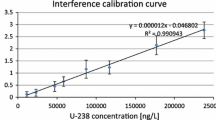Abstract
The validation of a method for the determination of chromium (Cr) in F-344/N rat tissues by inductively coupled plasma-mass spectrometry is described. Samples were analyzed after a rapid, open-vessel microwave digestion procedure. Performance of the method was evaluated using kidney tissue across a concentration range of 0.50–5.00 μg Cr/g tissue. Data for method linearity, accuracy, precision, digest stability, and storage stability are presented along with limits of detection and quantitation data. Data from a method cross-validation for B6C3F1 mouse kidney tissue are also presented. After validation, the method was applied to analyze samples collected in support of two chronic toxicity and carcinogenesis studies conducted by the National Toxicology Program.

Similar content being viewed by others
References
Agency for Toxic Substances and Disease Registry (2000) Toxicological profile for chromium. Agency for Toxic Substances and Disease Registry, Public Health Service, United States Department of Health and Human Services
Anderson RA (1989) Essentiality of chromium in humans. Sci Total Environ 86:75–81
Cohen MD, Kargacin B, Klein CB, Costa M (1993) Mechanisms of chromium carcinogenicity and toxicity. Crit Rev Toxicol 23:255–281
Costa M (1997) Toxicity and carcinogenicity of Cr(VI) in animal models and humans. Crit Rev Toxicol 27:431–442
Costa M, Klein CB (2006) Toxicity and carcinogenicity of chromium compounds in humans. Crit Rev Toxicol 36:155–163
Cubadda F, Giovannangeli S, Iosi F, Raggi A, Stacchini P (2003) Chromium determination in foods by quadrupole inductively coupled plasma-mass spectrometry with ultrasonic nebulization. Food Chem 81:463–468
Dufailly V, Noël L, Guérin T (2006) Determination of chromium, iron and selenium in foodstuffs of animal origin by collision cell technology, inductively coupled plasma mass spectrometry (ICP-MS), after closed vessel microwave digestion. Anal Chim Acta 565:214–221
Evans GW, Pouchnik DJ (1993) Composition and biological activity of chromium-pyridine carboxylate complexes. J Inorg Biochem 49:177–187
Federal Trade Commission (1996) Chromium picolinate cases. http://www.ftc.gov/opa/1996/11/nut-21.shtm. Accessed 28 Sept 2009
Hung CLH, Lau RKF, Lam JCW, Jefferson TA, Hung SK, Lam MHW et al (2007) Risk assessment of trace elements in the stomach contents of Indo-Pacific humpback dolphins and finless porpoises in Hong Kong waters. Chemosphere 66:1175–1182
International Agency for Research on Cancer (1990) Chromium. IARC Monogr Eval Carcinog Risks Hum 49:49–256
Krushevska A, Waheed S, Nóbrega J, Amarisiriwardena D, Barnes RM (1998) Reducing polyatomic interferences in the ICP-MS determination of chromium and vanadium in biofluids and tissues. Appl Spectrosc 52:205–211
Lagerwaard A, Woittiez JRW, Goeij JJM (1995) An independent accurate reference method for the determination of chromium in biological materials. Fresenius J Anal Chem 351:786–789
Levine KE, Stout MD, Ross GT, Essader AS, Perlmutter JM, Grohse PM, et al. (2009, in press) Validation of a method for the determination of total chromium in rat feces by inductively coupled plasma optical emission spectrometry. Anal Lett 43(1)
Minnich MG, Houk RS (1998) Comparison of cryogenic and membrane desolvation for attenuation of oxide, hydride, and hydroxide ions and ions containing chlorine in inductively coupled plasma mass spectrometry. J Anal At Spectrom 13:167–174
Mirasol F (2000) Chromium picolinate market sees robust growth and high demand. http://www.icis.com/Articles/Article.aspx?liArticleID=105617&PrinterFriendly=true. Accessed 28 Sept 2009
National Institutes of Health, Office of Dietary Supplements (2007) Dietary Supplement Fact Sheet: chromium. http://ods.od.nih.gov/factsheets/Chromium_pf.asp. Accessed 28 Sept 2009
National Toxicology Program (1998) Report on carcinogens, 8th edn. National Toxicology Program, Research Triangle Park, NC
National Toxicology Program (2008a) Toxicology and carcinogenesis studies of sodium dichromate dehydrate (CAS No. 7789-12-0) in F344/N rats and B6C3F1 mice (drinking water studies). NTP technical report 546, NIH Publication 07-5887
National Toxicology Program (2008b) Toxicology and carcinogenesis studies of chromium picolinate monohydrate (CAS No. 27882-76-4) in F344/N rats and B6C3F1 mice (feed studies). NTP technical report 556, NIH Publication 08-5897
Nicholson FA, Chambers BJ, Williams JR, Unwin RJ (1999) Heavy metal contents of livestock feeds and animal manures in England and Wales. Bioresour Technol 70:23–31
Nixon DE, Neubauer KR, Eckdahl SJ, Butz JA, Burritt MF (2002) Evaluation of a tunable bandpass reaction cell for an inductively coupled plasma mass spectrometer for the determination of chromium and vanadium in serum and urine. Spectrochim Acta B 57:951–966
O’Brien TJ, Ceryak S, Patierno SR (2003) Complexities of chromium carcinogenesis: role of cellular response, repair, and recovery mechanisms. Mutat Res 533:3–36
Proctor DM, Otani JM, Finley BL, Paustenbach DJ, Bland JA, Speizer N et al (2002) Is hexavalent chromium carcinogenic via ingestion? A weight-of-evidence review. J Toxicol Environ Health A 65:701–746
Séby F, Gagean M, Garraud H, Castetbon A, Donard OFX (2003) Development of analytical procedures for the determination of total chromium by quadrupole ICP-MS and high-resolution ICP-MS, and hexavalent chromium by HPLC-ICP-MS in different materials used in the automotive industry. Anal Bioanal Chem 377:685–694
Stout MD, Herbert RA, Kissling GE, Collins BJ, Travlos GS, Witt KL et al (2008) Hexavalent chromium is carcinogenic to F344/N rats and B6C3F1 mice following chronic oral exposure. Environ Health Perspect 117:716–722
Stout MD, Nyska A, Collins BJ, Witt KL, Kissling GE, Malarkey DE et al (2009) Chronic toxicity and carcinogenicity studies of chromium picolinate monohydrate administered in feed to F344/N rats and B6C3F1 mice for 2 years. Food Chem Toxicol 47:729–733
Vincent JB (2001) The bioinorganic chemistry of chromium(III). Polyhedron 20:1–26
Witmer CM, Park HS, Shupack SI (1989) Mutagenicity and disposition of chromium. Sci Total Environ 86:131–148
Acknowledgements
This work was funded in full by the National Institute of Environmental Health Sciences, National Institute of Health, Contract Nos. N01-ES-05455 and N01-ES-65554.
Author information
Authors and Affiliations
Corresponding author
Rights and permissions
About this article
Cite this article
Levine, K.E., Stout, M.D., Ross, G.T. et al. Validation and Application of a Method for the Determination of Total Chromium in Rat Tissues by Inductively Coupled Plasma Mass Spectrometry. Arch Environ Contam Toxicol 58, 883–891 (2010). https://doi.org/10.1007/s00244-009-9397-5
Received:
Accepted:
Published:
Issue Date:
DOI: https://doi.org/10.1007/s00244-009-9397-5




